Hide or display layers in PDF in Java
This article will demonstrate how to hide and display Layers in a PDF document using Spire.PDF for Java.
Hide all layers:
import com.spire.pdf.*;
import com.spire.pdf.graphics.layer.*;
public class invisibleAllPdfLayers {
public static void main(String[] args) {
//Load the sample document
PdfDocument doc = new PdfDocument();
doc.loadFromFile("layerSample.pdf");
for (int i = 0; i < doc.getLayers().getCount(); i++)
{
//Show all the Pdf layers
//doc.getLayers().get(i).setVisibility(PdfVisibility.On);
//Set all the Pdf layers invisible
doc.getLayers().get(i).setVisibility(PdfVisibility.Off);
}
//Save to document to file
doc.saveToFile("output/invisibleAllPdfLayers.pdf", FileFormat.PDF);
}
}

Hide some of the PDF layers:
import com.spire.pdf.*;
import com.spire.pdf.graphics.layer.*;
public class invisibleParticularPdfLayers {
public static void main(String[] args) {
//Load the sample document
PdfDocument doc = new PdfDocument();
doc.loadFromFile("layerSample.pdf");
//Hide the first layer by index
doc.getLayers().get(0).setVisibility(PdfVisibility.Off);
//Hide the layer by name with blue line1
for (int i = 0; i < doc.getLayers().getCount(); i++)
{
if("blue line1".equals(doc.getLayers().get(i).getName())){
doc.getLayers().get(i).setVisibility(PdfVisibility.Off);
}
}
//Save to document to file
doc.saveToFile("output/invisiblePaticularPdfLayers.pdf", FileFormat.PDF);
}
}
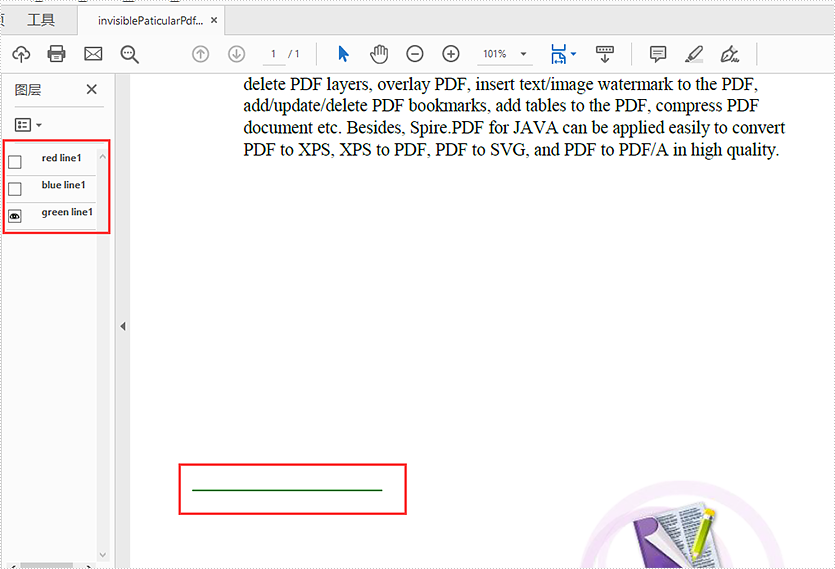
Java expand and collapse the bookmarks for PDF
This article will demonstrate how to expand or collapse the bookmarks when viewing the PDF files.
Expand all bookmarks on PDF
import com.spire.pdf.PdfDocument;
public class expandBookmarks {
public static void main(String[] args) {
PdfDocument doc = new PdfDocument();
doc.loadFromFile("Sample.pdf");
//Set true to expand all bookmarks; set false to collapse all bookmarks
doc.getViewerPreferences().setBookMarkExpandOrCollapse(true);
doc.saveToFile("output/expandAllBookmarks_out.pdf");
doc.close();
}
}
Output:

Expand specific bookmarks on PDF
import com.spire.pdf.PdfDocument;
import com.spire.pdf.bookmarks.*;
public class expandSpecificBookmarks {
public static void main(String[] args) {
PdfDocument doc = new PdfDocument();
doc.loadFromFile("Sample.pdf");
//Set BookMarkExpandOrCollapse as "true" for the first bookmarks
doc.getBookmarks().get(0).setExpandBookmark(true);
//Set BookMarkExpandOrCollapse as "false" for the first level of the second bookmarks
PdfBookmarkCollection pdfBookmark = doc.getBookmarks().get(1);
pdfBookmark.get(0).setExpandBookmark(false);
doc.saveToFile("output/expandSpecificBookmarks_out.pdf");
doc.close();
}
}
Only expand the first bookmarks
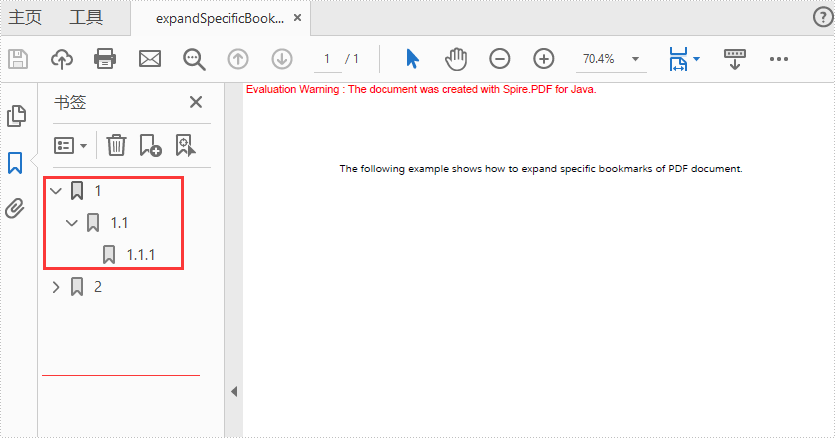
Java: Split a Worksheet into Several Excel Files
Splitting a worksheet can be beneficial when you have a large amount of data and want to organize it into separate files for easier management and sharing. By using this approach, you can organize and distribute your data in a more organized and structured manner. In this tutorial, we will demonstrate how to split a worksheet into multiple Excel documents by using Spire.XLS for Java.
Install Spire.XLS for Java
First of all, you're required to add the Spire.Xls.jar file as a dependency in your Java program. The JAR file can be downloaded from this link. If you use Maven, you can easily import the JAR file in your application by adding the following code to your project's pom.xml file.
<repositories>
<repository>
<id>com.e-iceblue</id>
<name>e-iceblue</name>
<url>https://repo.e-iceblue.com/nexus/content/groups/public/</url>
</repository>
</repositories>
<dependencies>
<dependency>
<groupId>e-iceblue</groupId>
<artifactId>spire.xls</artifactId>
<version>14.4.1</version>
</dependency>
</dependencies>
Split a Worksheet into Several Excel Files
Spire.XLS for Java provides powerful features that enable us to achieve this task efficiently. The specific steps are as follows.
- Create a Workbook object.
- Load a sample Excel file using Workbook.loadFromFile() method.
- Get the specific sheet using Workbook.getWorksheets().get() method.
- Get the header row and cell ranges using Worksheet.getCellRange() method.
- Create a new workbook and copy the header row and range 1 to the new workbook using Worksheet.copy(CellRange sourceRange, Worksheet worksheet, int destRow, int destColumn, boolean copyStyle, boolean updateRerence) method.
- Copy the column width from the original workbook to the new workbook using Workbook.getWorksheets().get(0).setColumnWidth() method.
- Save the new workbook to an Excel file using Workbook.saveToFile() method.
- Repeat the above operation to copy the header row and range 2 to another new workbook, and save it to another Excel file.
- Java
import com.spire.xls.CellRange;
import com.spire.xls.ExcelVersion;
import com.spire.xls.Workbook;
import com.spire.xls.Worksheet;
public class SplitWorksheet {
public static void main(String[] args) {
//Create a Workbook object to load the original Excel document
Workbook bookOriginal = new Workbook();
bookOriginal.loadFromFile("C:\\Users\\Administrator\\Desktop\\Emplyees.xlsx");
//Get the first worksheet
Worksheet sheet = bookOriginal.getWorksheets().get(0);
//Get the header row
CellRange headerRow = sheet.getCellRange(1, 1, 1, 5);
//Get two cell ranges
CellRange range1 = sheet.getCellRange(2, 1, 6, 5);
CellRange range2 = sheet.getCellRange(7, 1, 11, 5);
//Create a new workbook
Workbook newBook1 = new Workbook();
//Copy the header row and range 1 to the new workbook
sheet.copy(headerRow, newBook1.getWorksheets().get(0), 1, 1, true, false);
sheet.copy(range1, newBook1.getWorksheets().get(0), 2, 1, true, false);
//Copy the column width from the original workbook to the new workbook
for (int i = 0; i < sheet.getLastColumn(); i++) {
newBook1.getWorksheets().get(0).setColumnWidth(i + 1, sheet.getColumnWidth(i + 1));
}
//Save the new workbook to an Excel file
newBook1.saveToFile("Sales.xlsx", ExcelVersion.Version2016);
//Create another new workbook
Workbook newBook2 = new Workbook();
//Copy the header row and range 2 to the new workbook
sheet.copy(headerRow, newBook2.getWorksheets().get(0), 1, 1, true, false);
sheet.copy(range2, newBook2.getWorksheets().get(0), 2, 1, true, false);
//Copy the column width from the original workbook to another new workbook
for (int i = 0; i < sheet.getLastColumn(); i++) {
newBook2.getWorksheets().get(0).setColumnWidth(i + 1, sheet.getColumnWidth(i + 1));
}
//Save it to another new Excel file
newBook2.saveToFile("Technicians.xlsx", ExcelVersion.Version2016);
}
}
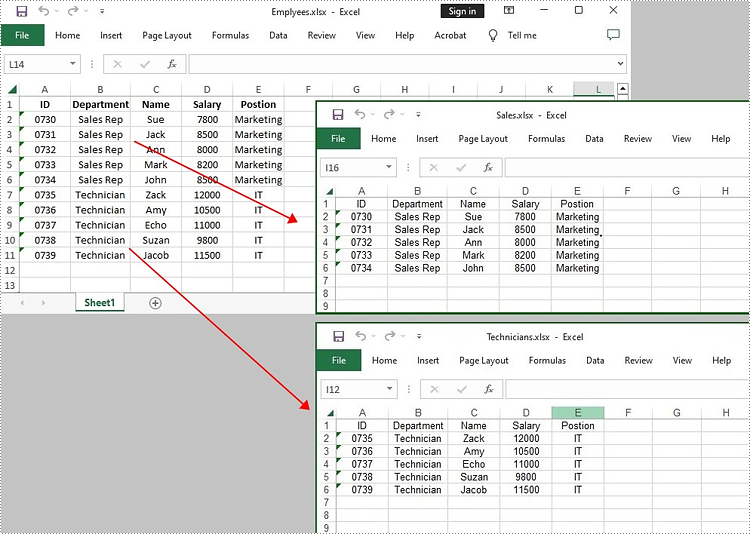
Apply for a Temporary License
If you'd like to remove the evaluation message from the generated documents, or to get rid of the function limitations, please request a 30-day trial license for yourself.
Java set the viewer preference and zoom factor for PDF
This article will demonstrate how to set the zoom factor/percentage (such as default, 100 percent or any other zoom factors as required) and the viewer preference by using Spire.PDF for Java in Java applications.
Set the zoom factor
import com.spire.pdf.*;
import com.spire.pdf.actions.*;
import com.spire.pdf.general.*;
import java.awt.geom.*;
public class setZoomFactor {
public static void main(String[] args) {
//Load the sample document
PdfDocument doc = new PdfDocument();
doc.loadFromFile("Sample.pdf");
//Get the first page of PDF
PdfPageBase page = doc.getPages().get(0);
//Set pdf destination
PdfDestination dest = new PdfDestination(page);
dest.setMode(PdfDestinationMode.Location);
dest.setLocation(new Point2D.Float(-40f, -40f));
//Set zoom factor
dest.setZoom(0.8f);
//Set action
PdfGoToAction gotoAction = new PdfGoToAction(dest);
doc.setAfterOpenAction(gotoAction);
//Save pdf document
String output = "output/setZoomFactor.pdf";
doc.saveToFile(output);
}
}
Output:

Set the viewer preference
import com.spire.pdf.*;
public class viewerPreference {
public static void main(String[] args) {
//Load the sample document
PdfDocument doc = new PdfDocument();
doc.loadFromFile("Sample.pdf");
//Set viewer reference
doc.getViewerPreferences().setCenterWindow(true);
doc.getViewerPreferences().setDisplayTitle(false);
doc.getViewerPreferences().setFitWindow(false);
doc.getViewerPreferences().setHideMenubar(true);
doc.getViewerPreferences().setHideToolbar(true);
doc.getViewerPreferences().setPageLayout(PdfPageLayout.Two_Column_Left);
//Save pdf document
String output = "output/viewerPreference.pdf";
doc.saveToFile(output);
}
}
Output:
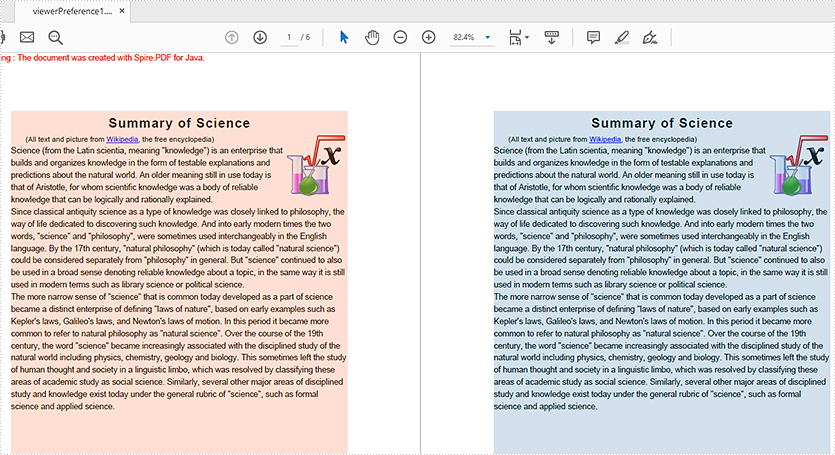
C#/VB.NET: Split Excel Sheets into Separate Files
A workbook containing multiple worksheets helps to centrally manage relevant information, but sometimes we have to split the worksheets into separate Excel files so that individual worksheets can be distributed without disclosing other information. In this article, you will learn how to split Excel worksheets into separate workbooks in C# and VB.NET using Spire.XLS for .NET.
Install Spire.XLS for .NET
To begin with, you need to add the DLL files included in the Spire.XLS for .NET package as references in your .NET project. The DLL files can be either downloaded from this link or installed via NuGet.
PM> Install-Package Spire.XLS
Split Excel Sheets into Separate Files
The following are the main steps to split Excel sheets into separate workbooks using Spire.XLS for .NET.
- Create a Workbook object
- Load a sample Excel file using Workbook.LoadFromFile() method.
- Declare a new Workbook variable, which is used to create new Excel workbooks.
- Loop through the worksheets in the source document.
- Initialize the Workbook object, and add the copy of a specific worksheet of source document into it.
- Save the workbook to an Excel file using Workbook.SaveToFile() method.
- C#
- VB.NET
using Spire.Xls;
using System;
namespace SplitWorksheets
{
class Program
{
static void Main(string[] args)
{
//Create a Workbook object
Workbook wb = new Workbook();
//Load an Excel document
wb.LoadFromFile("C:\\Users\\Administrator\\Desktop\\data.xlsx");
//Declare a new Workbook variable
Workbook newWb;
//Declare a String variable
String sheetName;
//Specify the folder path which is used to store the generated Excel files
String folderPath = "C:\\Users\\Administrator\\Desktop\\Output\\";
//Loop through the worksheets in the source file
for (int i = 0; i < wb.Worksheets.Count; i++)
{
//Initialize the Workbook object
newWb = new Workbook();
//Remove the default sheets
newWb.Worksheets.Clear();
//Add the specific worksheet of the source document to the new workbook
newWb.Worksheets.AddCopy(wb.Worksheets[i]);
//Get the worksheet name
sheetName = wb.Worksheets[i].Name;
//Save the new workbook to the specified folder
newWb.SaveToFile(folderPath + sheetName + ".xlsx", ExcelVersion.Version2013);
}
}
}
}

Apply for a Temporary License
If you'd like to remove the evaluation message from the generated documents, or to get rid of the function limitations, please request a 30-day trial license for yourself.
Java draw Superscript and Subscript Text in PDF
This article will show you how to use Spire.PDF for Java to draw superscript and subscript text to PDF file in Java applications.
Draw Superscript Text
import com.spire.pdf.*;
import com.spire.pdf.graphics.*;
import java.awt.*;
import java.awt.geom.*;
public class PdfSuperscriptText {
public static void main(String[] args) {
//Create a new PdfDocument instance
PdfDocument doc = new PdfDocument();
//Add a page to pdf
PdfPageBase page = doc.getPages().add();
//Set the font
PdfTrueTypeFont font = new PdfTrueTypeFont(new Font("Arial", Font.PLAIN,14),true);
PdfSolidBrush brush = new PdfSolidBrush(new PdfRGBColor(Color.black));
//Set initial (x, y) coordinate
float x = 120f;
float y = 100f;
//Draw text string
String text = "Sample Text";
page.getCanvas().drawString(text, font, brush, new Point2D.Float(x, y));
//Measure the string
Dimension2D size = font.measureString(text);
x += size.getWidth();
//Draw the text string and set the format as Superscript
PdfStringFormat format = new PdfStringFormat();
format.setSubSuperScript(PdfSubSuperScript.Super_Script);
text = "Superscrip";
page.getCanvas().drawString(text, font, brush, new Point2D.Float(x, y), format);
//Save the document to file
String result="output/superScript.pdf";
doc.saveToFile(result);
}
}
Effective screenshot:
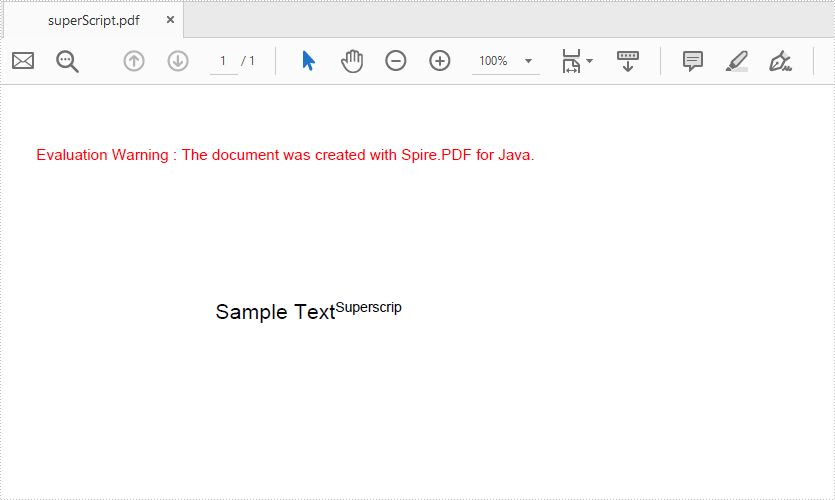
Draw Subscript Text
import com.spire.pdf.*;
import com.spire.pdf.graphics.*;
import java.awt.*;
import java.awt.geom.*;
public class PdfSubscriptText {
public static void main(String[] args) {
//Create a new PdfDocument instance
PdfDocument doc = new PdfDocument();
//Add a page to pdf
PdfPageBase page = doc.getPages().add();
//Set the font
PdfTrueTypeFont font = new PdfTrueTypeFont(new Font("Arial", Font.PLAIN,14),true);
PdfSolidBrush brush = new PdfSolidBrush(new PdfRGBColor(Color.black));
//Set initial (x, y) coordinate
float x = 120f;
float y = 100f;
//Draw text string
String text = "Sample Text";
page.getCanvas().drawString(text, font, brush, new Point2D.Float(x, y));
//Measure the string
Dimension2D size = font.measureString(text);
x += size.getWidth();
//Draw the text string and set the format as Subscript
PdfStringFormat format = new PdfStringFormat();
format.setSubSuperScript(PdfSubSuperScript.Sub_Script);
text = "Subscrip";
page.getCanvas().drawString(text, font, brush, new Point2D.Float(x, y), format);
//Save the document to file
String result="output/subScript.pdf";
doc.saveToFile(result);
}
}
Output:
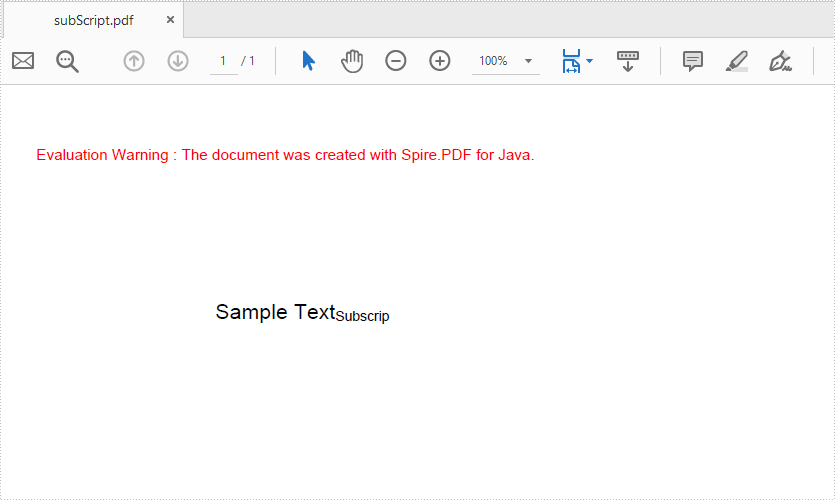
Split a Worksheet into Several Excel Files in Java
This article demonstrates how to split a worksheet into several Excel documents by using Spire.XLS for Java.
import com.spire.xls.CellRange;
import com.spire.xls.ExcelVersion;
import com.spire.xls.Workbook;
import com.spire.xls.Worksheet;
public class SplitWorksheet {
public static void main(String[] args) {
//Create a Workbook object to load the original Excel document
Workbook bookOriginal = new Workbook();
bookOriginal.loadFromFile("C:\\Users\\Administrator\\Desktop\\Emplyees.xlsx");
//Get the first worksheet
Worksheet sheet = bookOriginal.getWorksheets().get(0);
//Get the header row
CellRange headerRow = sheet.getCellRange(1, 1, 1, 5);
//Get two cell ranges
CellRange range1 = sheet.getCellRange(2, 1, 6, 5);
CellRange range2 = sheet.getCellRange(7, 1, 11, 5);
//Create a new workbook
Workbook newBook1 = new Workbook();
//Copy the header row and range 1 to the new workbook
sheet.copy(headerRow, newBook1.getWorksheets().get(0), 1, 1, true, false);
sheet.copy(range1, newBook1.getWorksheets().get(0), 2, 1, true, false);
//Copy the column width from the original workbook to the new workbook
for (int i = 0; i < sheet.getLastColumn(); i++) {
newBook1.getWorksheets().get(0).setColumnWidth(i + 1, sheet.getColumnWidth(i + 1));
}
//Save the new workbook to an Excel file
newBook1.saveToFile("Sales.xlsx", ExcelVersion.Version2016);
//Copy the header row and range 2 to another workbook, and save it to another Excel file
Workbook newBook2 = new Workbook();
sheet.copy(headerRow, newBook2.getWorksheets().get(0), 1, 1, true, false);
sheet.copy(range2, newBook2.getWorksheets().get(0), 2, 1, true, false);
for (int i = 0; i < sheet.getLastColumn(); i++) {
newBook2.getWorksheets().get(0).setColumnWidth(i + 1, sheet.getColumnWidth(i + 1));
}
newBook2.saveToFile("Technicians.xlsx", ExcelVersion.Version2016);
}
}
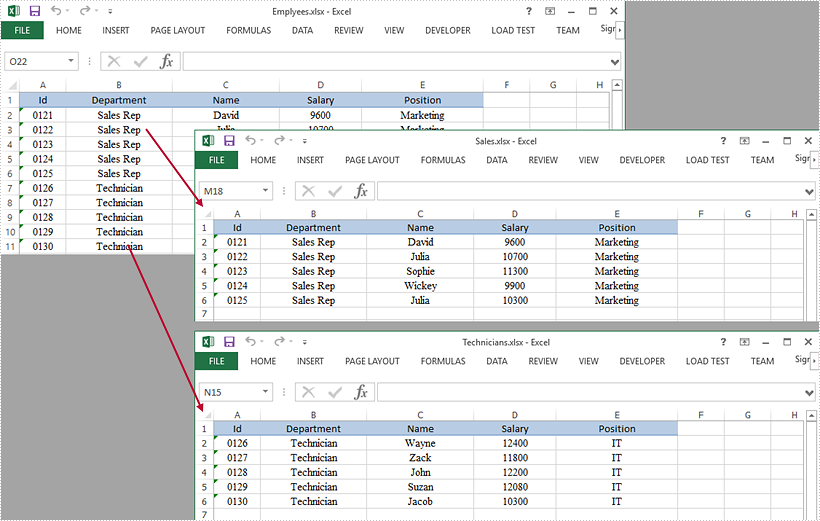
Java: Change Page Size and Page Orientation in Word
Normally, the default page size of a Word document is “Letter” (8.5 x 11 inches), and the default page orientation is “Portrait”. In most cases, the general page setup can meet the needs of most users, but sometimes you may also need to adjust the page size and orientation to design a different document such as an application form, certificate, or brochure. In this article, you will learn how to programmatically change the page size and page orientation in a Word document using Spire.Doc for Java.
Install Spire.Doc for Java
First of all, you're required to add the Spire.Doc.jar file as a dependency in your Java program. The JAR file can be downloaded from this link. If you use Maven, you can easily import the JAR file in your application by adding the following code to your project's pom.xml file.
<repositories>
<repository>
<id>com.e-iceblue</id>
<name>e-iceblue</name>
<url>https://repo.e-iceblue.com/nexus/content/groups/public/</url>
</repository>
</repositories>
<dependencies>
<dependency>
<groupId>e-iceblue</groupId>
<artifactId>spire.doc</artifactId>
<version>12.4.6</version>
</dependency>
</dependencies>
Change Page Size and Page Orientation in Word
The detailed steps are as follows:
- Create a Document instance.
- Load a sample Word document using Document.loadFromFile() method.
- Get the first section using Document.getSections().get() method.
- Change the default page size using Section.getPageSetup().setPageSize() method.
- Change the default page orientation using Section.getPageSetup().setOrientation() method.
- Save the document to file using Document.saveToFile() method.
- Java
import com.spire.doc.*;
import com.spire.doc.documents.*;
public class WordPageSetup {
public static void main(String[] args) throws Exception {
//Create a Document instance
Document doc= new Document();
//Load a sample Word document
doc.loadFromFile("sample.docx");
//Get the first section
Section section = doc.getSections().get(0);
//Change the page size to A3
section.getPageSetup().setPageSize(PageSize.A3);
//Change the page orientation to Landscape
section.getPageSetup().setOrientation(PageOrientation.Landscape);
//Save the document to file
doc.saveToFile("Result.docx",FileFormat.Docx_2013);
}
}
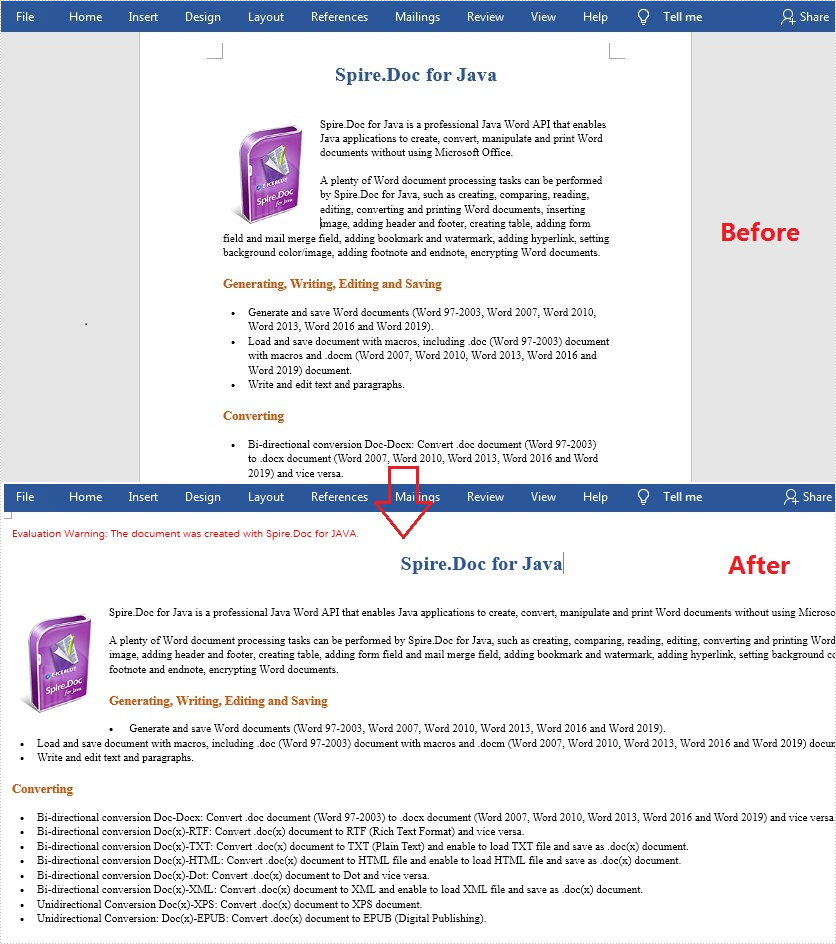
Apply for a Temporary License
If you'd like to remove the evaluation message from the generated documents, or to get rid of the function limitations, please request a 30-day trial license for yourself.
Embed an Excel File in a PowerPoint Document in Java
This article demonstrates how to insert an Excel file as an OEL object into a PowerPoint document using Spire.Presentation for Java.
import com.spire.presentation.FileFormat;
import com.spire.presentation.IOleObject;
import com.spire.presentation.Presentation;
import com.spire.presentation.SlideSizeType;
import com.spire.presentation.drawing.IImageData;
import javax.imageio.ImageIO;
import java.awt.geom.Rectangle2D;
import java.awt.image.BufferedImage;
import java.io.File;
import java.io.FileInputStream;
public class EmbedExcel {
public static void main(String[] args) throws Exception {
//Create a Presentation object
Presentation ppt = new Presentation();
ppt.getSlideSize().setType(SlideSizeType.SCREEN_16_X_9);
//Load an image file and add it to the image collection of the presentation
File file = new File("C:\\Users\\Administrator\\Desktop\\image.png");
BufferedImage image = ImageIO.read(file);
IImageData oleImage = ppt.getImages().append(image);
//Load an Excel file and convert it to byte[] object
String excelPath = "C:\\Users\\Administrator\\Desktop\\data.xlsx";
File excelFile = new File(excelPath);
FileInputStream inputStream = new FileInputStream(excelFile);
byte[] data = new byte[(int) excelFile.length()];
inputStream.read(data, 0, data.length);
//Create a Rectangle2D object
Rectangle2D rect = new Rectangle2D.Float(60, 60, image.getWidth(), image.getHeight());
//Insert the Excel file as an OLE object to the first slide
IOleObject oleObject = ppt.getSlides().get(0).getShapes().appendOleObject("excel", data, rect);
oleObject.getSubstituteImagePictureFillFormat().getPicture().setEmbedImage(oleImage);
oleObject.setProgId("Excel.Sheet.12");
//Save to another file
ppt.saveToFile("InsertOle.pptx", FileFormat.PPTX_2013);
}
}
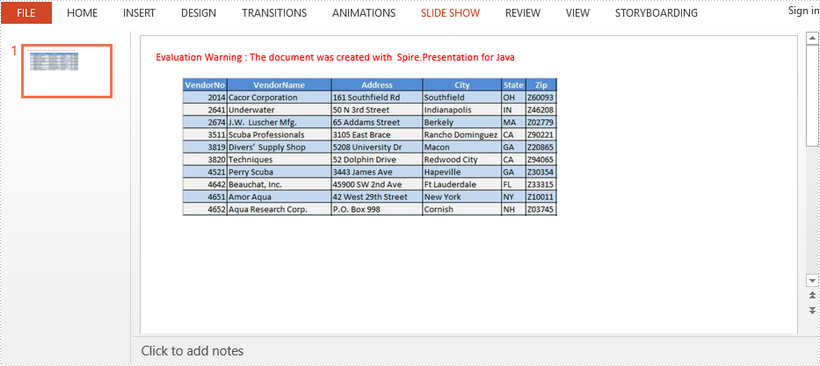
Remove Blank Lines in Word Document in Java
This article demonstrates how to remove blank lines/empty paragraphs in a Word document by using Spire.Doc for Java.
Below is the sample document which contains many blank lines:
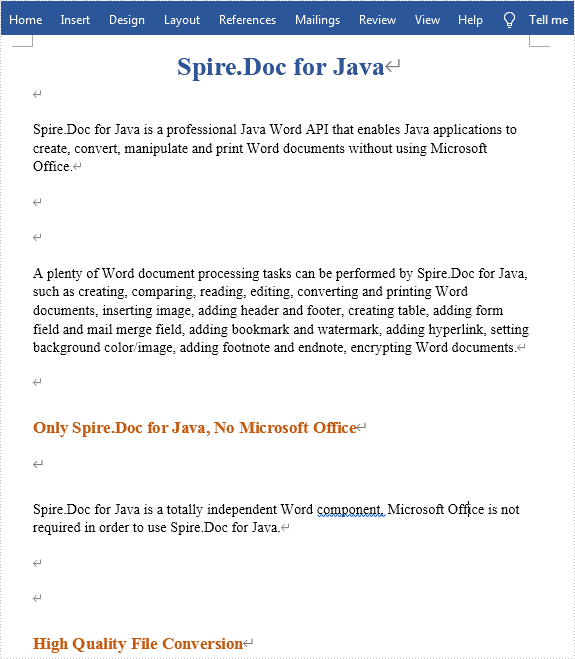
import com.spire.doc.*;
import com.spire.doc.documents.*;
public class removeBlankLines {
public static void main(String[] args) {
//Load the sample document
Document document = new Document();
document.loadFromFile("sample.docx");
//Traverse every section in the word document and remove the null and empty paragraphs
for (Object sectionObj : document.getSections()) {
Section section=(Section)sectionObj;
for (int i = 0; i < section.getBody().getChildObjects().getCount(); i++) {
if ((section.getBody().getChildObjects().get(i).getDocumentObjectType().equals(DocumentObjectType.Paragraph) )) {
String s= ((Paragraph)(section.getBody().getChildObjects().get(i))).getText().trim();
if (s.isEmpty()) {
section.getBody().getChildObjects().remove(section.getBody().getChildObjects().get(i));
i--;
}
}
}
}
//Save the document to file
String result = "removeBlankLines.docx";
document.saveToFile(result, FileFormat.Docx_2013);
}
}
